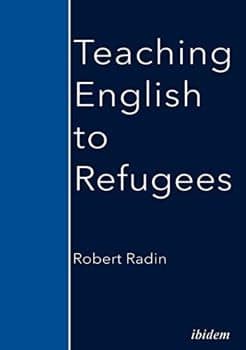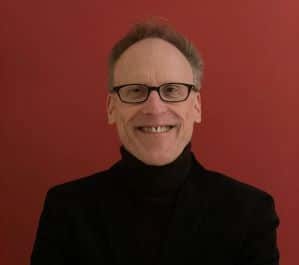On learning a first language and discovering 19th-century Brit lit
Cracking open Teaching English to Refugees, a mind-bending volume of philosophy, theology, and social justice, made me feel like I was in college again. I deeply appreciated this nod to my academically stimulating past, so it’s no surprise that I’d fallen in love by Chapter 2.
 In his quirky hybrid memoir, Robert Radin shares his experience of teaching adult refugees from far-flung, war-torn places like Iraq and Somalia. He writes beautifully about defying his students’ expectations of what “should” happen in the classroom by, among other things, nudging them to start thinking in English long before they’ve learned how to read it. And he makes them laugh, which is no small feat considering the violence they’ve seen.
In his quirky hybrid memoir, Robert Radin shares his experience of teaching adult refugees from far-flung, war-torn places like Iraq and Somalia. He writes beautifully about defying his students’ expectations of what “should” happen in the classroom by, among other things, nudging them to start thinking in English long before they’ve learned how to read it. And he makes them laugh, which is no small feat considering the violence they’ve seen.
It becomes obvious to readers that Radin isn’t just brilliant, he’s kind as well. He describes cooking an imaginary pot of pasta with his students, helping after a tornado, and reciting the mourner’s kaddish for his mother. It’s these deceptively simple moments of humanity that will stick with me long after I tuck Teaching English to Refugees into its spot on my bookshelf.
Both compassionate and unsettling, Teaching English to Refugees examines the ways that we seek safety for ourselves and look past our differences to that which binds us. In 118 miraculously lean pages, Radin succeeds in showing us that so many (odd) things are connected, like parallel parking and making stir fry and acquiring a new language. (It’s a mind-bending book, remember?)
One of my favorite aspects of Teaching English to Refugees is Radin’s push to find deeper meaning in everything, all while holding fast to his sense of humor and humility. “I’m simply acting, once again, like a jackass,” he writes, “searching for something essential, something transcendent, telling myself I can find it if I just use different words.”
Me too, Robert. Me too.
Originally from Los Angeles, Radin lives with his wife and cat in Western Massachusetts, and he has a college-age son.
***
You are the director of citizenship and immigration services for a social service agency. Can you tell me about your work?
We serve refugees and immigrants from all over the world. In Springfield we have refugee communities from the Democratic Republic of Congo, Bhutan, Syria, Iraq, Eritrea, Somalia, Sudan, and Myanmar. We have a very big Dominican community. Recently we’ve been assisting a lot of folks from Venezuela.
We represent clients in their petitions before the United States Department of Homeland Security. We do many different kinds of petitions. Let’s say someone wants to get a green card, or bring family members to the United States, or become a citizen: We provide legal counsel, prepare and file their applications, and, if needed, represent them at their interviews. We also offer classes to help people prepare for their citizenship interviews.
I wish we could accompany all of our clients to their interviews, but we’re a small staff, and we have a lot of clients. I accompany someone if she has a more complicated case that involves some form of trauma, like domestic violence or sex trafficking. Really I’m there to provide moral support so the client knows she’s not alone, and that she has someone who can speak on her behalf should she need it.
What about the English classes that feature prominently in your book?
I typically had about 20 students in a class. My students were refugees from the countries I mentioned earlier. In the early years, I might have someone in class for up to six months. Over time there was increasing pressure at both the federal and state level for people to find jobs right away, so I might get to work with someone for only a month or even just a couple of weeks. This was certainly the most frustrating part of the work.
I got into it quite by accident: I was teaching high-school social studies in Los Angeles in 1986 when Congress passed the Immigration Reform and Control Act. One of the provisions for a pathway to residence was a certain degree of proficiency in English, and California provided funding for classes to help people meet this requirement. Los Angeles had a large number of undocumented residents, so the demand for classes was overwhelming. The school district was pulling in teachers from everywhere to meet the need; a lot of teachers were moonlighting, teaching English at night. That’s how I got into it, and I loved it, though I did it for only a year before I left L.A. to attend graduate school in Massachusetts. When I finished grad school I knew I wanted to return to this work.
The teaching method I describe in Teaching English to Refugees reproduces—insofar as it’s possible to do so in a classroom—the conditions of infancy and early childhood, the conditions under which we all learn our first language. It allows teachers to meet each student where they are. There’s no pressure, no stress. Some students may remain silent for a long time, just listening, but the language is building in them, and when they take the initiative and speak for the first time, or stand up, of their own volition, and walk to the front of the room to do something, it’s quite thrilling for all of us. We’re all bearing witness to this person’s milestone.
It’s pure theater; you don’t know what’s going to happen in a given class, who’s going to have a breakthrough. When I had a new group and would start pantomiming an activity for them—something they engaged in every day or needed to learn how to engage in every day—they were utterly, completely riveted. No one said a word in any language, but the atmosphere was electric. They simply couldn’t believe what they were seeing, that this kind of learning was possible, or permissible. As I say in the book, I always hated mimes as a kid, and I still do. When I watch a mime I can’t tell if I’m feeling ashamed for myself, or for them. But doing this work forced me into a kind of grudging respect for what they do.
What inspired you to write Teaching English to Refugees?
I’d always kept my work life and my writing life separate. One activity was public, the other private, both vital. Then I wrote a short story describing a bit of what I did in the classroom for Leah Browning, the editor of an online literary journal called Apple Valley Review. When the piece was selected as a notable story for that year’s Best American Short Stories, I realized this was something people might want to learn more about, so I decided to turn it into a larger project.
I love that your book is a hybrid of memoir, essay, philosophy—and other things, to boot. How and why did you structure it this way?
I studied philosophy in college, and have never gotten over it.
A lot of the things I’d been telling myself over the years—elaborations or revisions of arguments made by certain post-structuralist writers I’d been fond of once—just didn’t add up anymore, didn’t square with my experience teaching English, especially to learners who weren’t literate in their first language.
This book is really my attempt to answer some nagging questions that are typically the province of philosophy, but to do so in a very personal way, to locate my answers in my experience, not just as a teacher but as a father and a husband and a son. I don’t want to say much more than that, as I hope people will read the book and draw their own conclusions.
The hybrid form took shape as I wrote. I tend not to think about form in advance; the most important thing for me is to locate myself in the narrative, to establish what my role is. Often when I’m struggling with a piece it’s because I haven’t done this.
I always try to be direct, to dissolve the difference between myself and the narrator, or attenuate it as much as possible. At the same time, I don’t want to overdetermine a piece of writing, so I use certain techniques more often associated with fiction—like dialogue—to give the reader space to interpret. The form of this book is a function of that, of my attempt to resolve this abiding tension, to reconcile my desire to be both present and absent.
Who are your favorite authors?
I didn’t study literature in school. I’ve always read purely for pleasure, and consequently there are huge gaps in my reading. As a younger man I read everything by Kafka, Dostoevsky, Marquez, Calvino, Abish, Kundera. Men. I read books by women, but the only woman writer I read in an exhaustive way was Marguerite Duras.
I reached a point where I was tired of hearing men’s voices, not just in literature, but in music, in film, in television. And I wanted to fill in some of the gaps in my reading, and one of the biggest gaps was in 19th-century British literature, so I started reading my wife’s old books from college and all the great women writers from this period. These books are so familiar to many readers, so any recommendations I might make will only beg the question “Where the hell has this guy been?” But I love Jane Austen and Charlotte Brontё.
What else keeps you fulfilled?
Teasing my son, or really enduring his teasing, is at once a withering and delicious affair. And watching television and movies with my wife, who I simply adore. And watching my cat follow my wife around the house with utter devotion. And watching the white baby bunny rabbit who has enchanted our entire neighborhood spending the better part of his day on our lawn, because he likes our lawn the best.
To order Teaching English to Refugees and learn more about Robert Radin, please visit https://www.robertradinbooks.com/.
- Northwoods Author Amy Pease Interview and Book Recommendations - April 29, 2024
- Still True author Maggie Ginsberg:Interview and Book Recommendations - September 14, 2022
- When wood and words come together:A children’s picture book is born - June 30, 2022


Loved this interview Laura!
As a fellow English Language teacher and coach for over ten years in a vast rural province of Southern Italy, the author’s points of reference and experience seem prescient for the challenges we face. Looking forward to reading & recommending Robert Radin’s Teaching English to Refugees.